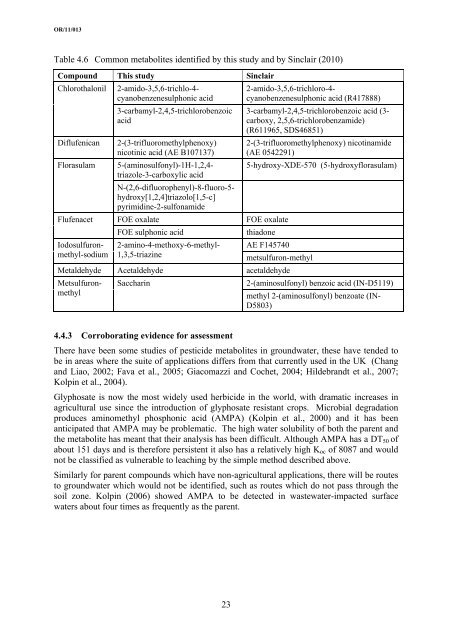Emerging contaminants in groundwater - NERC Open Research ...
Emerging contaminants in groundwater - NERC Open Research ...
Emerging contaminants in groundwater - NERC Open Research ...
Create successful ePaper yourself
Turn your PDF publications into a flip-book with our unique Google optimized e-Paper software.
OR/11/013<br />
Table 4.6 Common metabolites identified by this study and by S<strong>in</strong>clair (2010)<br />
Compound This study S<strong>in</strong>clair<br />
Chlorothalonil<br />
2-amido-3,5,6-trichlo-4cyanobenzenesulphonic<br />
acid<br />
3-carbamyl-2,4,5-trichlorobenzoic<br />
acid<br />
Diflufenican 2-(3-trifluoromethylphenoxy)<br />
nicot<strong>in</strong>ic acid (AE B107137)<br />
Florasulam 5-(am<strong>in</strong>osulfonyl)-1H-1,2,4triazole-3-carboxylic<br />
acid<br />
N-(2,6-difluorophenyl)-8-fluoro-5hydroxy[1,2,4]triazolo[1,5-c]<br />
pyrimid<strong>in</strong>e-2-sulfonamide<br />
Flufenacet FOE oxalate FOE oxalate<br />
Iodosulfuronmethyl-sodium<br />
FOE sulphonic acid thiadone<br />
2-am<strong>in</strong>o-4-methoxy-6-methyl-<br />
1,3,5-triaz<strong>in</strong>e<br />
23<br />
2-amido-3,5,6-trichloro-4cyanobenzenesulphonic<br />
acid (R417888)<br />
3-carbamyl-2,4,5-trichlorobenzoic acid (3carboxy,<br />
2,5,6-trichlorobenzamide)<br />
(R611965, SDS46851)<br />
2-(3-trifluoromethylphenoxy) nicot<strong>in</strong>amide<br />
(AE 0542291)<br />
5-hydroxy-XDE-570 (5-hydroxyflorasulam)<br />
AE F145740<br />
metsulfuron-methyl<br />
Metaldehyde Acetaldehyde acetaldehyde<br />
Metsulfuronmethyl<br />
Sacchar<strong>in</strong> 2-(am<strong>in</strong>osulfonyl) benzoic acid (IN-D5119)<br />
methyl 2-(am<strong>in</strong>osulfonyl) benzoate (IN-<br />
D5803)<br />
4.4.3 Corroborat<strong>in</strong>g evidence for assessment<br />
There have been some studies of pesticide metabolites <strong>in</strong> <strong>groundwater</strong>, these have tended to<br />
be <strong>in</strong> areas where the suite of applications differs from that currently used <strong>in</strong> the UK (Chang<br />
and Liao, 2002; Fava et al., 2005; Giacomazzi and Cochet, 2004; Hildebrandt et al., 2007;<br />
Kolp<strong>in</strong> et al., 2004).<br />
Glyphosate is now the most widely used herbicide <strong>in</strong> the world, with dramatic <strong>in</strong>creases <strong>in</strong><br />
agricultural use s<strong>in</strong>ce the <strong>in</strong>troduction of glyphosate resistant crops. Microbial degradation<br />
produces am<strong>in</strong>omethyl phosphonic acid (AMPA) (Kolp<strong>in</strong> et al., 2000) and it has been<br />
anticipated that AMPA may be problematic. The high water solubility of both the parent and<br />
the metabolite has meant that their analysis has been difficult. Although AMPA has a DT50 of<br />
about 151 days and is therefore persistent it also has a relatively high Koc of 8087 and would<br />
not be classified as vulnerable to leach<strong>in</strong>g by the simple method described above.<br />
Similarly for parent compounds which have non-agricultural applications, there will be routes<br />
to <strong>groundwater</strong> which would not be identified, such as routes which do not pass through the<br />
soil zone. Kolp<strong>in</strong> (2006) showed AMPA to be detected <strong>in</strong> wastewater-impacted surface<br />
waters about four times as frequently as the parent.

















